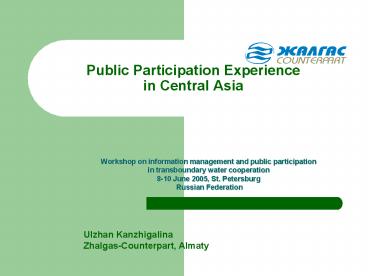Public Participation Experience in Central Asia - PowerPoint PPT Presentation
1 / 19
Title:
Public Participation Experience in Central Asia
Description:
I would like to express my gratitude to the people from Counterpart ... Erkinbek Kasymbekov, Counterpart Kyrgyzstan Director ... National Concept for ... – PowerPoint PPT presentation
Number of Views:104
Avg rating:3.0/5.0
Title: Public Participation Experience in Central Asia
1
Public Participation Experience in Central Asia
- Workshop on information management and public
participation - in transboundary water cooperation
- 8-10 June 2005, St. Petersburg
- Russian Federation
Ulzhan Kanzhigalina Zhalgas-Counterpart, Almaty
2
ACKNOWLEDGEMENTS
- I would like to express my gratitude to the
people from Counterpart International who
provided advice and shared their experiences in
encouraging participation in Central Asia - Michael Kuntz, Counterpart Regional Director
- Erkinbek Kasymbekov, Counterpart Kyrgyzstan
Director - Mark Granius, Counterpart Program Specialist
3
(No Transcript)
4
(No Transcript)
5
LEGAL FRAMEWORK
- Aarhus Convention
- National Concept for Ecological security, 2003
- Agreement between the Government of Kazakhstan
and the Government of Kyrgyz Republic on
Utilization of the Water Facilities of Interstate
Use on the Chu and Talas Rivers, 2000 - Water Code, 2003, Art. 43
- Draft concept for the National IWRM and Water
Efficiency Plan, 2005
6
LEVELS OF PARTICIPATION
- Information
- Consultation
- Participation
7
CHALLENGES and SOLUTIONS
8
METHODS AND PRACTICAL TOOLS THE CHU-TALAS
PROJECT
- Project Goal To promote public participation in
decision-making on issues of management of
transboundary waters of the Chu and Talas Rivers.
- Mapping stakeholders
- Focus groups to identify local stakeholders
needs - Information/Stakeholders Directory/Data Base
- Capacity Building Plan
- Mechanisms to voice the needs to decision makers
9
COMMUNITY MOBILIZATION METHODOLOGY
- OBJECTIVES
- Support and promote community initiatives in
participatory problem solving - Create local entities that can sustainably
support, promote community development
initiatives and protect citizens' interests
10
COMMUNITY MOBILIZATION CYCLE
11
PARTICIPATORY COMMUNITY APPRAISAL (PCA)
- PCA is a flexible methodological framework
- to mobilize communities for implementing
solutions - of their own self-defined needs
- Identification and prioritization of the key
community needs and potential solutions - Identification of available and needed internal
and external resources - Constructive engagement of government, media,
NGOs, community members and businesses a.k.a.
Social Partnership - Elected Community Initiative Group with roles and
responsibilities to manage implementation of
community decisions
12
COMMUNITY ACTION PLAN (CAP)
- The CAP articulates
- Specific problem to be solved
- Actions to address the identified problem
- Who will be involved
- Action and intervention planned timeline
- How actions will be implemented
- Resources required
- Local resources that have been identified
- Expected results
13
COMMUNITY ACTION GRANT (CAG)
- The CAG application must include
- Articulation of the participatory community
appraisal and action planning processes - Listing and prioritization of community projects
developed to address those identified needs - Level of community and local government
contributions - Participation and partnership with local
businesses - Participation of women, youth, and marginalized
segments - Project feasibility study and sustainability plan
14
PARTICIPATION TOOLS
- Participatory Rural Appraisal Tools such as the
VEN diagram, community mapping, stakeholder
analysis, priority matrix - Training for community leaders on topics such as
Facilitation Skills, Participatory Community
Appraisal, Project Design, Fundraising, Social
Partnership and Participatory M E - Public meetings and information mechanisms such
as budget hearings, suggestion boxes and
community information boards
15
PARTICIPATORY APPROACH SUCCESS FACTORS
- Consistent community mobilization methodology
- Relevant facilitation of community mobilization
process - Quick success, overcome skepticism, build
momentum - Sustainability and maintenance plans
- Cost share ownership, project results
maintenance - Grant is a supplement to community
self-initiatives - Implement and enforce procurement standards
- Success should be recognized and celebrated
- Ownership and transparency mechanisms
- Recognition of contributions
16
TANGABLE PARTICIPATION IMPACTS
- Improved Infrastructure A community council in
rural Uzbekistan utilized participatory
techniques in installing 8.4 kilometres of water
pipe. The local government was so impressed with
the efficiency of the projects implementation
and the impact that the project had on the
community, they engaged the council and used the
same techniques to provide residents from the
neighbouring community with new water pipe.
Nearly 15,000 residents from these two
communities now have reliable access to potable
water.
17
TANGABLE PARTICIPATION IMPACTS
- Behavior Change In Uzbekistan, villages are
learning from their neighbors about the power of
community mobilization. After seeing the results
of a road repair project in the Chech-Dobo
Village, community members from neighboring
Jar-Korgon Village requested PCA activities to
fix their main road. The community reconstructed
8 km of the road and contributed 400 plus labor
costs to the project.
18
TANGABLE PARTICIPATION IMPACTS
- Behavior Change In Kazakhstan, PCA exercises in
the city of Aqtobe resulted in road repairs on
one of the main thoroughfares in the city. In
addition, the community applied to the local
government and a local business to repair a
neighboring water pipe. The local government and
business provided repair of the streets, cleaning
gutters and building a water pipe for the
districts needs. Hence, PCA approach and
community initiatives lead to effective decision
making processes for solving local problems.
19
TANGABLE PARTICIPATION IMPACTS
- Public Budget Hearings Although initially
reticent, city government officials of Pavlodar
held an open forum to provide citizens with an
opportunity to ask questions and comment directly
on proposed budget changes. Local government
officials provided budget information to the
public and widely publicized the public budget
hearing. In preparation, USAID advisors held a
roundtable discussion for local media, NGOs, city
officials and others to help them better
understand public participation. Over 200
persons, including citizens, city department and
agency heads, and NGO advocates, actively
participated. This new willingness of local
government officials to consider their
constituents' views is a good example of the
progress being achieved in making local
governments more responsive and accountable.































